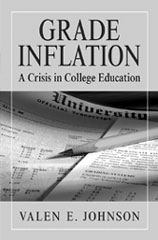|  The
Statistics of Standards Erosion: An Interview with Dr. Valen Johnson The
Statistics of Standards Erosion: An Interview with Dr. Valen Johnson
by Mitchell
Levine
In
the mid-Nineties, as a professor of Biostatistics at Duke University,
Valen Johnson noticed a strange phenomenon occurring in the
grading system of that highly regarded institution: Almost
half the GPAs awarded by the college were in fact A to A pluses.
Although some variation was displayed across the different
programs—arts and humanities departments were far less stringent
in their grading than the sciences—it was clear that what he
refers to as a “crisis of standards” was threatening the integrity
of the academic process.
In
his book, Grade Inflation: A Crisis in College Education [Springer-Verlag,
2003], he details the circumstances that led to his research
program, which he named DUET (Duke Undergraduates Evaluate
Teaching), into the causes of this breakdown in intellectual
vetting. After having his proposal to create a new system that
substituted an “achievement index,” a weighted average to compensate
for variations in grading strictness, for the traditional scheme
handily vetoed by professors in several different departments,
he set up a website that allowed students to deliver their
teacher evaluations online. By matching their commentary with
their averages and cross-referencing it against the grade norms
of their classes in particular and the departments and the
college itself as a whole, he learned something that should
shock no one, but surprised everyone: teachers are motivated
to assign students the grades they feel they deserve, because
it leads to advancement for their careers. Speaking with Education
Update, Dr. Johnson described his discovery: “Tenure and
status promotions are in large part determined on the basis
of student evaluations as a key factor. Students tend to view
the process with an attribution bias: If they score well, it’s
because of their intelligence and hard work. If they don’t,
it’s because the grading was too strict.”
With
these two tendencies interacting, teachers will often be pressured
to grade leniently just to pander to their classes and their “enrollment
vote.” Other theories, like the idea that classes with excellent
teaching simply learn more and therefore score higher on average,
or that self-selection of courses by motivated students lead
to higher grades, he was able to discredit on the basis of
a quantitative analysis of the data he was able to collect.
Instead, it indicated that the correlation between grades and “Student
Evaluations of Teaching (or SET) ratings is due to grade attribution
and to a smaller extent to intervening factors.” That is, instructors
who grade more severely are likely to have more students give
them lower SET ratings than the instructors who grade less
so, because they feel that it is the instructor’s fault that
they are earning a lower grade. One of the biggest myths his
research was able to dispel is the commonly held, if counterintuitive,
notion that SETs are actually measures of student learning:
Even if it is true that students don’t directly award teachers
uniformly higher ratings simply for grading leniently, their
ratings are still indices of student satisfaction, and not
higher levels of understanding of the course material.
Interestingly
enough, he tells us, the problem probably can’t actually get
much worse than it is now. In fact, if it did almost every
student would be receiving highest marks. Nonetheless, the
situation as it stands, he feels, is seriously undermining
the credibility of higher education. When students dictate
grades, and grad schools demonstrate indifference to grading
their enrollees after those students have been admitted, who
will be able to ensure that the graduates academia turns out
are truly qualified in their fields?
The
solution he proposes manages to be as surprisingly simple to
explain, as it was impossible for him to politically implement.
All that would be necessary to counteract the upward biasing,
he claims, would be to just ignore the lowest and highest 10
percent or 20 percent of the class when tabulating the ratings,
since these two groups are the most likely to be grade-biased
when evaluating their instructors. Unfortunately, as reasonable
as this sounds, no school that he knows of has been able to
set such a policy in motion. He sums up the problem in a simple
epigram: “To right the boat, two things must happen (and) more
principled student grading practices must be adopted, and faculty
assessment must be more closely linked to student achievement.”
When
asked if it was fair that students graded with a weighted measure
of performance instead of a traditional grade point average
would be placed at a disadvantage when competing with students
from institutions with “grade-biased” academics for admissions
into graduate programs, he admitted that it would be a liability
for them, but also points out that it would lead to more solidly
prepared candidates overall. Students with valid measures of
learning available will therefore have deeper insight into
how much they are actually learning, and will thus be empowered
to learn more.
Any
reader desiring to understand the true dynamics of grade assessment
and academic integrity in higher education today—and that should
include anyone teaching at, studying in, paying tuition to,
or hiring graduates from any American college or university—must
give themselves a flunking mark if they have not read this
book.#

Education
Update, Inc., P.O. Box 1588, New York, NY 10159.
Tel: (212) 477-5600. Fax: (212) 477-5893. Email: ednews1@aol.com.
All material is copyrighted and may not be printed without express consent of
the publisher. © 2003.
|
